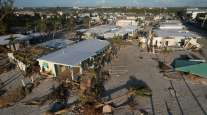Business Continuity Plans Needed for Fleets to Avoid Permanent Shutdown, Experts Say
This story appears in the April 21 print edition of Transport Topics.
Disasters, both man-made and natural, come in all shapes and sizes, but regardless of the source, the only way to minimize disruptions to business is to have a comprehensive disaster-recovery plan in place, fleet managers and industry experts said.
When a Category 5 tornado touched down in Joplin, Mo., in May 2011, management at Con-way Truckload, a Con-way division headquartered there, had mere minutes to get its 400 employees to cover, said Randy Cornell, vice president of maintenance.
“We have a tornado-evacuation plan where everybody goes to a predetermined location,” Cornell told Transport Topics. “There were no injuries on the property. There was a lot of debris, so there were logistical issues getting employees in and out, but there were no injuries.”
The eye of the tornado passed within half a mile of Con-way’s four buildings. Some were damaged, along with 28 tractors and 53 trailers, but the on-site power systems worked and operations never went down, Cornell said.
Sam Rizzitelli, director of Inland Marine Transportation with insurer Travelers Indemnity Co., based in Hartford, Conn., said that without a disaster-recovery plan — also called a business-continuity or DR/BC plan — a company could be shut down permanently.
A good plan minimizes disruptions and restores business operations, he said. Most plans include a similar list of actions and responsibilities — such as making sure company records are backed up, preferably at an off-site location, or restoring power. But each emergency plan is customized to the company’s needs.
For carriers, that may mean having a second brick and mortar facility that can be used if the home office can’t be, as well as a plan for truck maintenance and repair if the shop is damaged, Rizzitelli said.
“If the maintenance shop is damaged, for example, is there key equipment you need to keep the vehicles going?” he asked.
Rizzitelli added, “You have to plan for the worst-case scenario to get up and running as soon as possible.”
“Companies can’t afford to be down and not operational,” said Bobby Spencer, sales executive with Agility Recovery, a third-party service supplier based in Charlotte, N.C. “According to former [Federal Emergency Management Agency] chief David Paulison, 40% to 60% of the companies that suffer lost business because of a disaster don’t come back.”
FEMA’s responsibilities include providing assistance to communities recovering from disasters.
Having a DR/BC plan also can be a competitive advantage, Spencer added. “A lot of shippers are requiring carriers to have a disaster-recovery plan in place to do business.”
Making sure employees are safe is the first action they take in emergencies, fleet managers said.
“We have a fairly detailed
[disaster-recovery] plan,” said Gary Frantz, director of communications for Con-way Inc., in Ann Arbor, Mich. “Our first priority is the safety of the employees. Once we determine that all employees are safe, then we turn our attention to our operations.”
As with Con-way, Bill Dawson, vice president of operations for Ryder System’s Northeast and Central operating areas, said their first recovery focus is on its employees.
“We have a program [called] ‘Send Word Now,’ which takes into account the location and the safety of the people,” he said. “We identify the condition and locate our folks. We use voice, text and e-mail to ensure we get the message to everyone of some danger approaching. Sometimes it takes physically going to the house.”
Every plan should have a checklist of actions that need to be done, stating who is responsible for doing what, executives said. Everyone should be able to easily understand things such as key contacts and emergency information and actions.
“Having a team checklist — who is responsible for doing what — is very important,” said Bethann Rooney, security manager with the Port Authority of New York and New Jersey.
“It becomes the guide for accountability. With the checklist, it puts accountability on people,” she said.
Superstorm Sandy devastated much of the New Jersey and lower New England coastlines in October 2012. The storm caused flooding in lower Manhattan and forced the port of Elizabeth, N.J., to close for a week.
Rooney said notices to the port’s tenants began three days before the storm’s predicted landfall, and the port was evacuated and closed by the morning of Monday, Oct. 29, when it hit.
“Because of the plan and the measures we took, we recovered quickly on Tuesday morning,” she said.
Between 50 and 60 of Ryder System’s facilities in the path of Sandy were “significantly impacted,” said Dawson. “We lost a significant amount of equipment. One used-truck facility lost every truck on the lot. These included hourly, rental and customer-leased vehicles.”
And Tom Connery, chief operating officer of the Shevell Group — based in Elizabeth, N.J., and parent of New England Motor Freight, Eastern Freight Ways and Carrier Industries — told TT after Sandy that the company had moved units to higher ground and generators maintained power to its headquarters.
But Connery said, “For a two-day period, we did about 60% of our normal revenue.”
Not all business interruption events are large, said Michael Merz, strategic sales manager with Agility, but good planning will maintain continuity in any event.
“The majority of recoveries in the past winter, especially in the South, were for power. In fact, 40% of the disasters we responded to in 2013 were due simply to a power outage,” he said. Agility, a subscription-based supplier, provides work space, temporary power, communications and an IT infrastructure, such as computers and servers.
Communication networks may go down quickly, so have backup plans in place, if possible, executives said.
“The problem with tornados is that the phone system is almost nonexistent,” Con-way’s Cornell said. “There were no land lines, and the cellphones were unreliable. We couldn’t phone or talk, but, interestingly, we could text and e-mail.”
“Communication is always a big deal,” Rooney said . “Cellphones, for example, are only as good as the ability to charge them. That was compromised [after Sandy] because of a lack of power. We are so dependent on technology that we are all vulnerable.”
DR/BC plans must be flexible and should be adjusted as needed.
One of the changes the Port Authority made to its DR plan after Sandy was to include paper copies of all necessary information, Rooney said.
However, regardless of whether the plan is new or updated, she said, “Anybody who tells you their plan worked flawlessly is lying.”
Ryder brought in generators to restore power at some facilities after Sandy, but its experience with them illustrated Rooney’s point.
“Getting mobile generators to shops was relatively easy, but getting qualified electricians to install them and get them working was really difficult,” Dawson said.
Con-way Truckload’s previous tornado safety plan called for maintenance-shop workers to take shelter in the floor pits during tornados and severe storms. But during the 2011 tornado, small tools and debris began flying around the shop.
“We realized the pits were not the best option, so we installed six tornado shelters throughout the property,” Cornell said.
The Joplin tornado was responsible for 162 deaths, according to the Joplin Globe.
Ryder’s Dawson said his operation looks at ways to improve its plan using experiences from each event.
“We get a little better each time,” he said. “We learned from Sandy how important communications are. With the polar vortex this past winter, we knew it was coming, so we prepared our customers. We advised customers on how to keep vehicles running.
Also, we set up a process for our road-service response team where calls would roll over to a third-party service. If we hadn’t lived through Sandy, maybe we wouldn’t have been as robust in our communications and preparations as we were.”
Since computerized records are now the lifeblood of business, it’s hard to imagine that any company may not be backing up its data with duplicates or at an off-site location, but it may be possible, Travelers’ Rizzitelli said.
“While it’s easy to be complacent about some parts of a plan, it’s very easy to copy and maintain [data] off premises,” he said. “We’ve found that a lot of businesses are diligent about data storage.”
Con-way Truckload’s off-site data center is in Portland, Ore., Cornell said, and Acme Truck Line, in Gretna, La., opened a company-owned backup data center in Austin, Texas.




